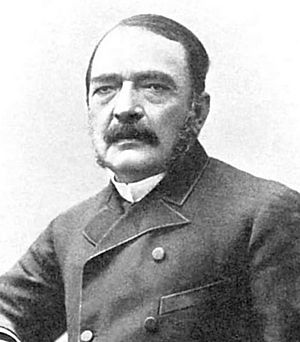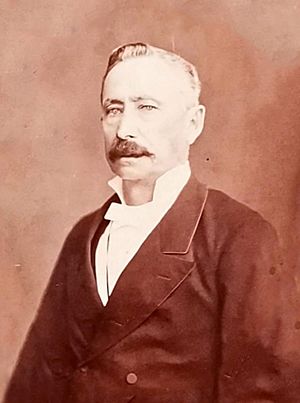Aniceto Arce facts for kids
Quick facts for kids
Aniceto Arce
|
|
|---|---|
 |
|
| 22nd President of Bolivia | |
| In office 15 August 1888 – 11 August 1892 |
|
| Vice President | José Manuel del Carpio Serapio Reyes Ortiz |
| Preceded by | Gregorio Pacheco |
| Succeeded by | Mariano Baptista |
| 4th Vice President of Bolivia | |
|
First Vice President
|
|
| In office 31 May 1880 – 11 March 1881 Serving with Belisario Salinas
|
|
| President | Narciso Campero |
| Preceded by | Mariano Enrique Calvo |
| Succeeded by | Mariano Baptista |
| Minister of Finance | |
| In office 18 October 1862 – 22 December 1862 |
|
| President | José María de Achá |
| Preceded by | Rudecindo Carvajal |
| Succeeded by | Melchor Urquidi |
| Personal details | |
| Born |
Aniceto Arce Ruiz de Mendoza
15 April 1824 Padcaya, United Provinces of the Río de la Plata (now Bolivia) |
| Died | 14 August 1906 (aged 82) Sucre, Bolivia |
| Political party | Conservative Constitutional |
| Spouse | Amalia Argandoña Revilla |
| Parents | Diego Antonio Arce Josefa Ruiz de Mendoza |
| Education | University of Saint Francis Xavier |
| Signature |  |
Aniceto Arce Ruiz de Mendoza (born April 15, 1824, in Tarija – died August 14, 1906) was an important Bolivian lawyer and politician. He served as the 22nd president of Bolivia from 1888 to 1892. Before that, he was the fourth vice president of Bolivia from 1880 to 1881, working with President Narciso Campero. A part of Bolivia, the Aniceto Arce Province, is named after him.
Contents
Early Life and Career
Aniceto Arce was born to Diego Antonio Arce and Josefa Ruiz de Mendoza. His family was part of the wealthy and important group of people during the time of the Viceroyalty of the Río de la Plata (a Spanish colony).
Even though he was born in Tarija, Arce studied to become a lawyer and lived most of his life in Sucre. There, he became one of the richest people in the country because of his silver mines.
Starting in Politics
Arce supported José María Linares, who was president and later declared himself a dictator (a ruler with total power). Arce started his political career in the Bolivian Congress (a group of elected officials who make laws) during Linares's time. He continued in Congress until the 1870s.
When the War of the Pacific started in 1879, Arce did not join the army. He believed Bolivia should try to make peace with Chile. This was partly because he had many business connections in Chile. He sold his silver there, invested his money, and found funding for his projects.
Arce thought that Bolivia's coastal area (called the Litoral) was hard to defend. He felt Bolivia should accept its losses and try to become friends with Chile instead of staying allied with Peru.
Founding the Conservative Party
Even with his different ideas about the war, many Bolivians liked Arce's strong belief in a stable, conservative government. He wanted a country where laws were followed, elections happened regularly, and smart, business-minded leaders like himself were in charge.
To achieve this, he created the Conservative Party. He helped remove General Hilarión Daza from power in 1880 and played a role in writing Bolivia's new Constitution. He also agreed to become Narciso Campero's vice-president from 1880 to 1884, a time when Bolivia was rebuilding.
Personal Life
Aniceto Arce was married to Amalia Argandoña Revilla. Her brother, Francisco Argandoña, was a very wealthy man and became Arce's business partner.
Arce even encouraged Francisco to marry Clotilde de Urioste Velasco. She came from a powerful family in Sucre and was the sister of Atanasio de Urioste Velasco, one of Arce's biggest critics.
Despite their political differences, Atanasio Urioste once saved Arce's life. When an angry crowd surrounded the Cathedral of Sucre, planning to harm the president, Urioste helped Arce escape by disguising him as a priest and taking him to his own home.
Vice President and Return to Politics
Disagreement and Exile
Arce's idea of being friendly with Chile caused problems with President Campero. Campero was a strong patriot and wanted Bolivia to rearm and fight Chile, or at least get other countries to help solve the conflict.
Arce, however, believed Bolivia had lost its access to the Pacific Ocean for good. He felt the best thing to do was to make a deal with Chile, even if it meant ending the alliance with Peru. President Campero saw this as a betrayal. In 1881, he sent Arce, who was his own vice-president, out of Bolivia.
Coming Back and the 1884 Election
Eventually, Arce was allowed to return to Bolivia. He quickly announced he would run for president as the Conservative Party candidate in the 1884 elections. These were the first elections under the new Constitution since 1873.
Many people expected Arce to win, but he lost by a small amount to Gregorio Pacheco. Pacheco was even richer than Arce and known for his charity work. He promised to run the country efficiently, without focusing on politics.
Since both Arce and Pacheco were wealthy silver miners from the south and shared similar conservative, pro-business ideas, they made a deal. Pacheco agreed to become president and, in return, he would make Arce his vice-president. He also promised to support the Conservative Party candidate in the next election.
President of Bolivia
Leading the Country
As they had agreed, Pacheco supported Arce in the 1888 elections. So, in August 1888, Aniceto Arce, the leader of the Conservative Party, finally became president at 64 years old.
Arce was a strong leader. He helped Bolivia make many important improvements. For example, the first railway line inside Bolivia was finished, connecting the Chilean border to Oruro. He also brought electricity to several Bolivian cities. He created new, modern laws for banking and investments.
Arce strongly believed in free business and wanted foreign companies to invest in Bolivia. He faced many rebellions from people who supported the Liberal Party, but he managed to stay in power because of his determined personality. He finished his full term and, in 1892, handed over power to another Conservative leader, his vice-president Mariano Baptista.
Later Life and Death
Retirement and the 1904 Election
After his time as president, Arce retired from politics. However, he remained an important advisor to the Conservative Presidents Baptista (1892–1896) and Severo Fernández (1896–1899).
He was forced back into politics when the Liberal Party took power after the Civil War of 1899. They tried to prosecute him politically.
Surprisingly, the elderly Arce was still allowed to run for president in the 1904 general elections. This was probably because he was 80 years old, not very popular, and seemed easy to defeat. The Conservative Party he had founded was struggling, but Arce, who was always ready for a challenge, decided to run against the popular Liberal candidate Ismael Montes. Arce lost by a very large margin, the biggest in Bolivian election history at that time.
His Legacy
After this election, the former president completely retired from politics. He went to live on his large farm and died two years later in 1906, at the age of 82.
Aniceto Arce is remembered for his strong personality and his firm belief in a civilian, democratic government (even if it was mostly run by a small group of wealthy people). He also helped set up a modern political party system in Bolivia.
See also
 In Spanish: Aniceto Arce para niños
In Spanish: Aniceto Arce para niños



